Decorating a living room is a delightful endeavor that allows you to infuse your personal style and create a space that exudes comfort and charm. However, it can also be a daunting task, especially when you’re unsure of where to begin or how to achieve a cohesive look.
Fear not! In this comprehensive guide, we will walk you through the best tips to decorate a living room from start to finish, helping you turn your space into a stunning haven that reflects your unique personality and meets your lifestyle needs.
So, you’ve decided to revamp your living room, but you’re wondering where to start? Follow these expert tips to ensure a successful and visually appealing transformation. Let’s start with what pieces of furniture you should consider for your living room.
In This Post:
Must have pieces of furniture
Determine your style and theme
Consider the room’s functionality
Measure your space
Starting with the sofa
Create a focal point
Choose an inviting color scheme
Select the right furniture
Arrange furniture for conversation
Add layers of lighting
Incorporate texture and patterns
Introduce natural elements
Personalized with art and accessories
Define zones within the room
Create a shopping list
Conclusion
FAQs
1. Must-Have Pieces of Furniture to Consider for Your Living Room

When decorating your living room, there are certain essential pieces of furniture that can elevate the functionality and style of the space. Here are a few must-have pieces to consider:
- Sofa or Sectional: A comfortable and well-designed sofa or sectional serves as the centerpiece of your living room. Choose one that suits your style and accommodates the seating needs of your household. Opt for high-quality upholstery that withstands daily use and complements your color scheme.
- Coffee Table: A coffee table not only provides a convenient surface for drinks and snacks but also adds visual interest to the room. Look for a sturdy and stylish coffee table that complements the overall aesthetic. Consider options with built-in storage to keep remote controls, books, or magazines within reach.
- Media Console: If you have a television or entertainment system in your living room, a media console is a practical addition. It offers storage for electronics, game consoles, and media accessories while keeping cables organized. Choose a media console that harmonizes with your other furniture pieces.
- Accent Chairs: Accent chairs not only provide additional seating but also inject personality into your living room. Select chairs that complement your sofa or sectional while adding visual interest through their design or upholstery. Consider versatile options that can be easily rearranged for different seating arrangements.
- Bookshelves or Shelving Units: If you’re an avid reader or enjoy displaying decor items and books, bookshelves or shelving units are essential. They offer storage and display opportunities while adding vertical visual interest. Opt for open shelves or choose bookshelves with glass doors to protect cherished items.
- TV Stand: If you prefer a separate TV stand instead of a media console, choose one that complements your overall design style. Ensure it has ample storage for media components and accessories while providing stability for your television.
- Side Tables: Side tables are not only practical for holding drinks or table lamps but also offer a place to display decorative accents. Choose side tables that complement your other furniture and consider options with storage shelves or drawers for added functionality.
- Ottoman or Pouf: An ottoman or pouf serves as a versatile piece of furniture in your living room. It can be used as a footrest, additional seating, or even as a makeshift coffee table when paired with a tray. Look for options that complement your existing furniture and can easily be moved around the room.
- Area Rug: An area rug is a versatile and impactful addition to your living room decor. It not only enhances the visual appeal of the space but also adds comfort and warmth underfoot. When choosing an area rug, consider the size, style, and placement to create a cohesive and inviting atmosphere.
- Lighting: Think about the lighting needs in your living room and add items such as floor lamps, table lamps, or overhead lighting fixtures to your list. Choose lighting options that enhance the ambiance and provide both task and mood lighting.
- Window Curtains: If needed, include window treatments such as curtains, blinds, or shades on your list. Consider the style and privacy requirements of your living room.
- Accessories: Add decorative items such as throw pillows, artwork, mirrors, plants, and vases to your list. These accents add personality and help tie the overall design together.
Remember, the key is to select furniture that combines both style and functionality, aligning with your personal taste and the overall design concept of your living room. With these must-have pieces, you’ll create a comfortable and visually appealing space for relaxation, entertainment, and socializing.
2. Determine Your Style and Theme
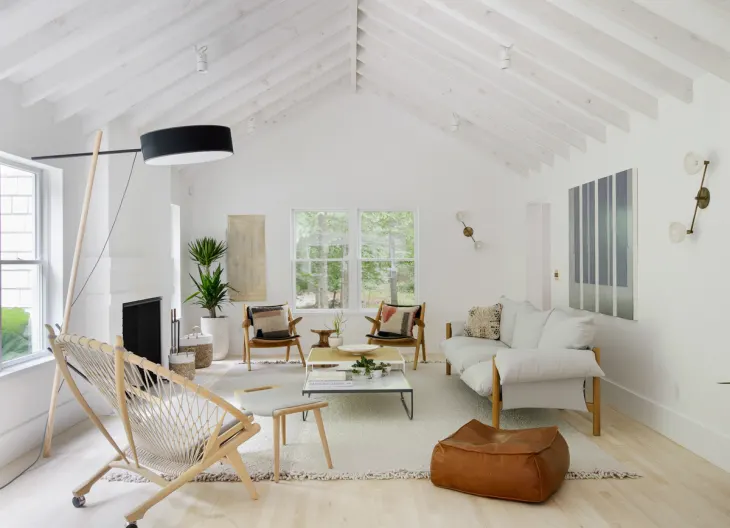
Before diving into the world of home decor, it’s important to establish the style and theme that resonates with you. This step sets the foundation for your entire design journey.
Take some time to explore different interior design styles and identify the one that aligns with your preferences. Do you prefer a modern and minimalist aesthetic or a cozy and rustic ambiance? Perhaps you lean towards a traditional and elegant look or a bohemian and eclectic vibe.
By determining your style and theme, you can make informed choices throughout the decorating process, ensuring a harmonious and cohesive result.
3. Consider the Room’s Functionality
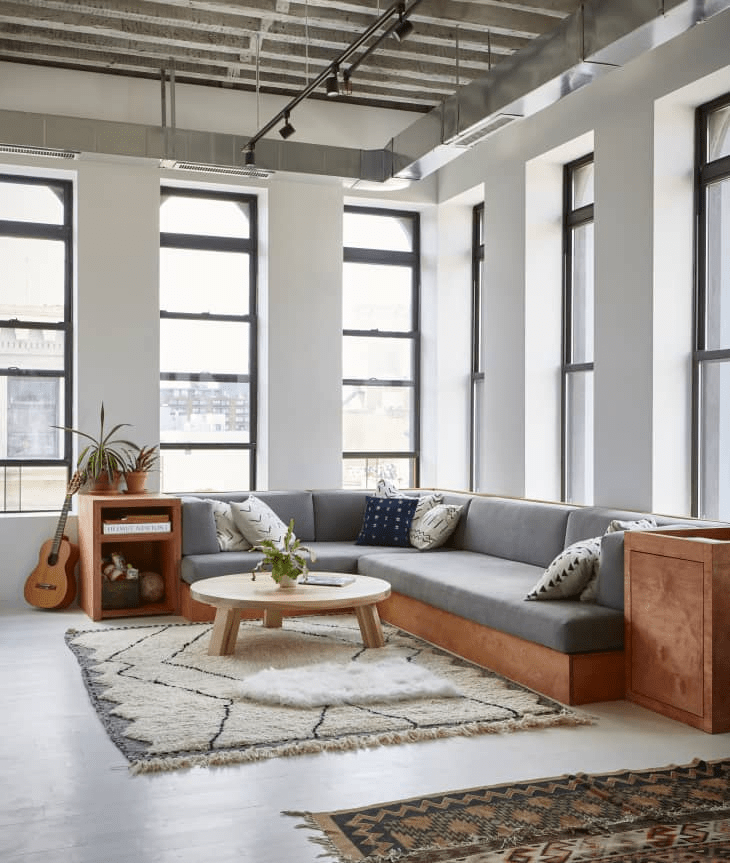
Before diving into the process of decorating your living room, it’s essential to define the function and purpose of the space. The function of your living room may vary depending on your lifestyle, preferences, and the needs of your household.
Defining the function of your living room helps guide your design choices and ensures that the space is tailored to your specific needs. It allows you to create a room that seamlessly integrates with your lifestyle and enhances the overall functionality and enjoyment of your home.
Whether it’s a space for entertainment, socializing, work, or a combination of functions, understanding its purpose sets the foundation for a well-designed and inviting living room.
Finally, understanding the room’s functionality will help you make informed decisions when selecting furniture, lighting, and storage solutions.
“If you are looking for a way to style your space with wall art without breaking your piggy bank, then I recommend reading “10 Surprising Benefits of Printable Wall Art”
4. Measure Your Space
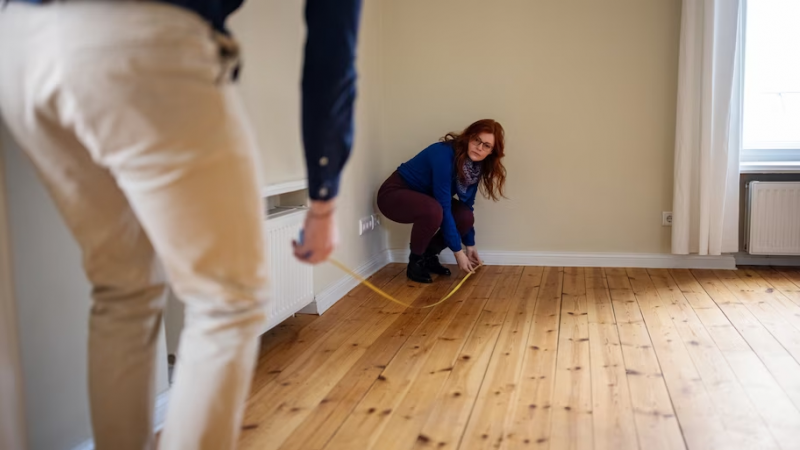
Before embarking on the process of decorating your living room, it’s crucial to accurately measure the space. Proper measurements help you determine the right furniture sizes, plan the layout effectively, and ensure that everything fits harmoniously within the room. Here’s a brief guide on how to measure your living room:
- Overall Room Dimensions: Start by measuring the overall dimensions of your living room. Use a tape measure to measure the length and width of the room from wall to wall. Note down these measurements, as they will serve as the foundation for your furniture arrangement and layout planning.
- Doorways and Entryways: Measure the width and height of the doorways and entryways leading into your living room. This step is essential to ensure that any new furniture pieces can fit through the door and be easily transported into the room. Consider the path from the main entrance of your home to the living room and identify any potential obstacles or narrow passages that may affect furniture delivery or placement.
- and Architectural Features: Measure the dimensions of windows, including the height and width. Note the location of windows and any architectural features such as fireplaces, built-in shelves, or alcoves. These measurements will help you plan the placement of furniture and determine the best way to incorporate these elements into your design.
- Wall Space: Measure the length and height of each wall in your living room. Pay attention to any alcoves, niches, or protruding walls that may affect furniture placement. These measurements will help you determine the appropriate size and placement of larger furniture items like sofas, media consoles, and bookshelves.
- Clearance and Walkways: Consider the flow and movement within your living room. Measure the clearance space between furniture pieces, ensuring that there is enough room for comfortable movement and easy access. Allow for ample walkways around the furniture arrangement to avoid a cramped or cluttered feel.
By taking accurate measurements of your living room, you gain a solid understanding of the space you have to work with. These measurements serve as a valuable reference when selecting furniture, planning the layout, and visualizing the overall design.
Remember to double-check your measurements and take into account any obstructions or architectural elements that may impact the arrangement. With precise measurements, you can confidently proceed with decorating your living room, knowing that each furniture piece will fit seamlessly into the space.
5. Starting with the Sofa
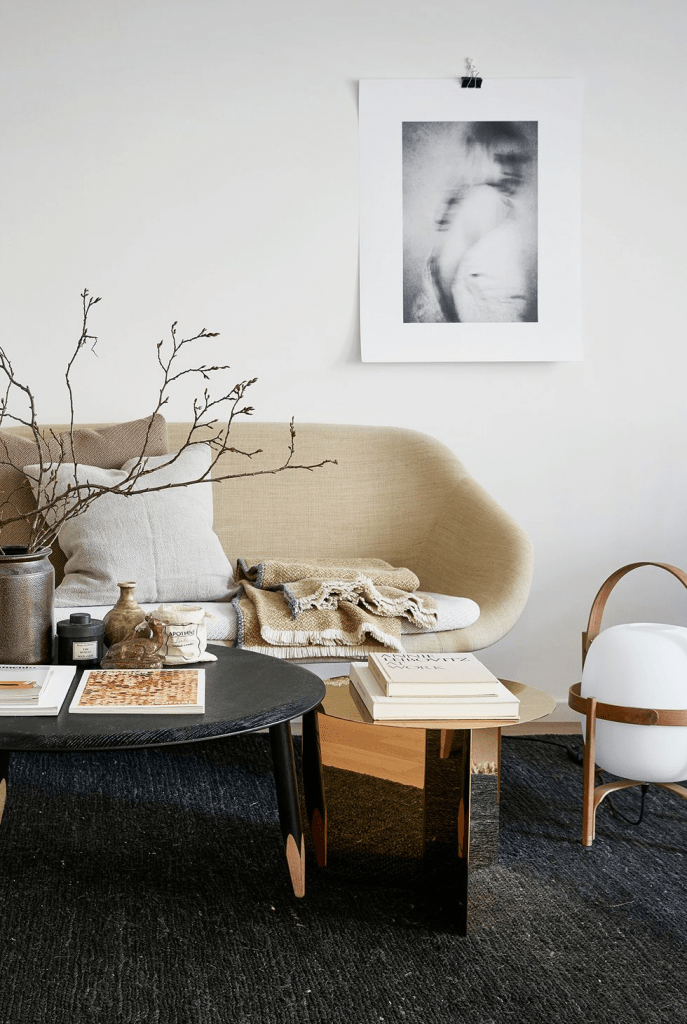
When it comes to decorating your living room, the sofa often takes center stage as one of the most essential and prominent furniture pieces. It sets the tone for the entire space and serves as a hub for relaxation, conversation, and gathering. Therefore, it’s a good idea to start your decorating journey by selecting the perfect sofa for your living room.
Consider the size of your living room and choose a sofa that proportionally fits the space. Measure the available area to ensure the sofa will fit comfortably without overwhelming the room or obstructing walkways. Think about the number of seats you require and whether a traditional sofa or a sectional would better suit your needs.
6. Create a Focal Point
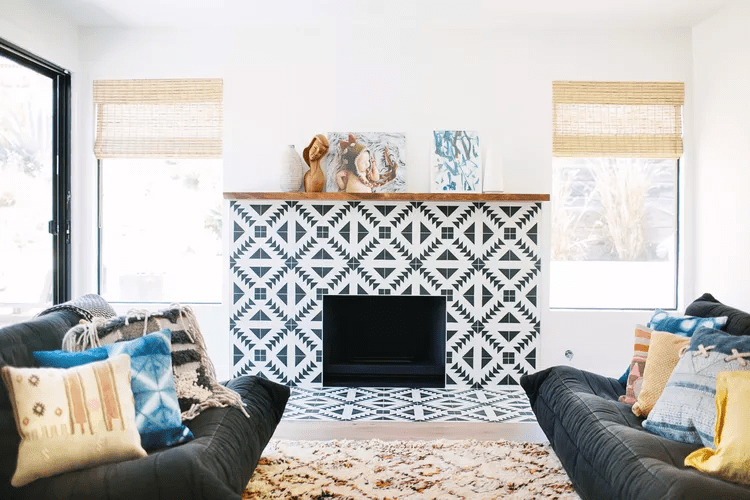
Every well-decorated living room needs a focal point that draws the eye and anchors the space. A focal point is a visually striking element that immediately captures attention and becomes the centerpiece of the room. It could be an eye-catching piece of artwork, a stunning fireplace, or a statement furniture item like a unique sofa or a stylish coffee table.
By choosing a focal point, you establish a visual hierarchy in the room and set the tone for the entire space. It becomes the starting point from which you build the rest of your decor elements.
7. Choose an Inviting Color Scheme
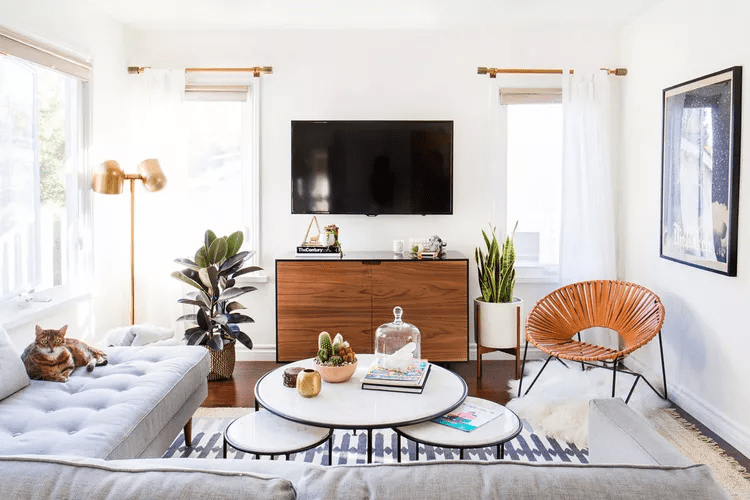
Colors play a crucial role in creating the desired atmosphere in your living room. They have the power to evoke emotions, influence moods, and set the overall ambiance. When selecting a color scheme, consider the mood you want to create in your living room.
Soft neutrals like beige, cream, and gray create a calm and sophisticated atmosphere, while warm earth tones like browns and oranges bring a cozy and inviting feel. If you’re seeking vibrancy and energy, opt for bold and vibrant hues like blues, yellows, or reds.
Remember to choose colors that complement your chosen style and create a harmonious visual flow throughout the space.
8. Select the Right Furniture
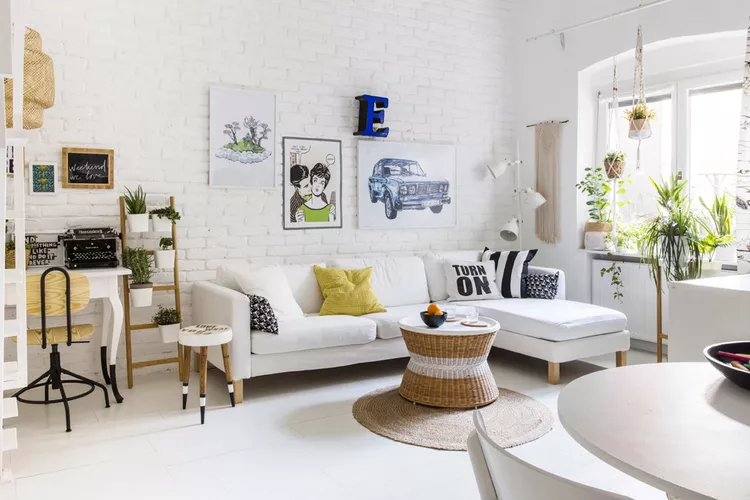
Furniture selection is a vital aspect of decorating a living room. The furniture you choose not only contributes to the overall aesthetics of the room but also determines the comfort and functionality of the space.
Before making any purchases, consider the room’s layout and size. Measure the dimensions of your living room to ensure that the furniture you select fits proportionally and allows for easy movement. It’s important to strike a balance between style and practicality.
Invest in comfortable and high-quality pieces that align with your chosen style and provide the functionality you need. Whether you opt for a sleek and modern sofa or a cozy sectional, choose furniture that reflects your personal taste and caters to your lifestyle.
9. Arrange Furniture for Conversation
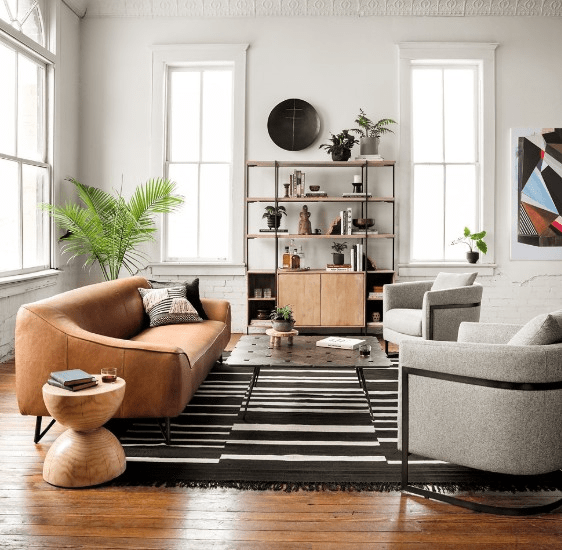
One of the key purposes of a living room is to facilitate social interaction and create a warm and inviting atmosphere for conversations. When arranging your furniture, consider the layout and flow of the room.
Arrange your seating in a way that encourages conversation and creates a natural gathering space. Position your sofas and chairs in a way that allows people to face each other comfortably.
Place a coffee table or ottoman in the center as a convenient surface for drinks and snacks. Avoid pushing furniture against the walls, as it can create a sense of distance and detachment. Instead, create intimate seating arrangements that foster a sense of togetherness. This arrangement not only promotes conversation but also maximizes the functionality of the space.
10. Add Layers of Lighting
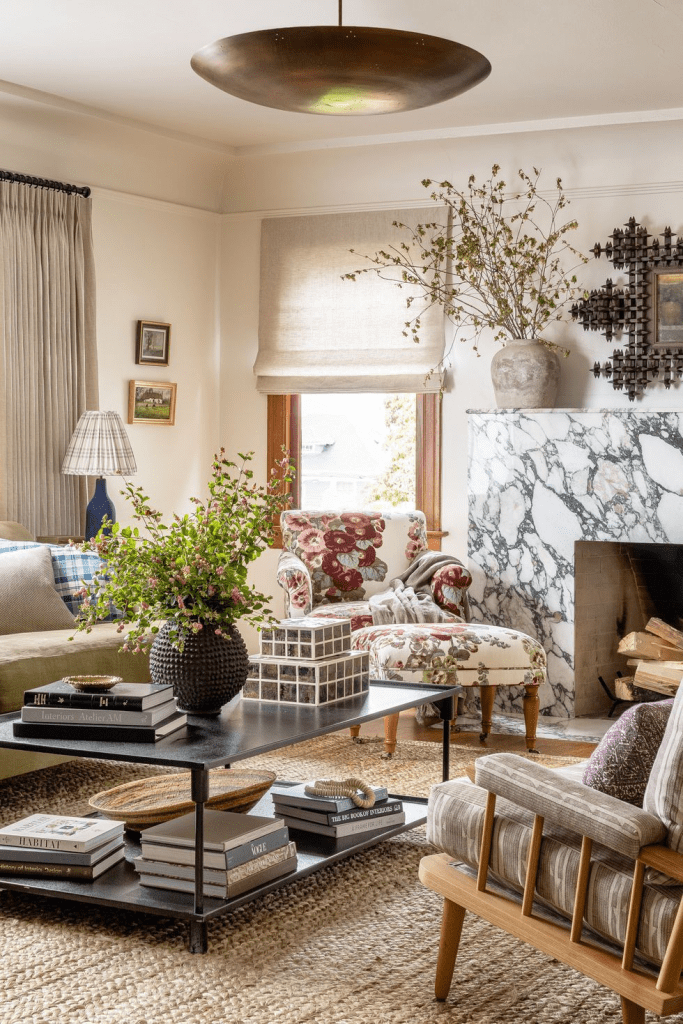
Lighting is an often-overlooked element that can transform the ambiance of a room. It has the power to create different moods and enhance the overall aesthetic appeal. To create a well-lit living room, incorporate a variety of lighting sources and layer them strategically.
Start with ambient lighting, which provides overall illumination for the entire room. This can be achieved through ceiling fixtures or recessed lighting. Next, introduce task lighting to illuminate specific areas where activities like reading or working may take place. Table lamps, floor lamps, or adjustable wall sconces work well for this purpose.
Finally, add accent lighting to highlight architectural features, artwork, or decorative elements. This can be achieved using track lighting or well-placed spotlights. By incorporating different types of lighting, you can create a warm, inviting atmosphere and add depth and dimension to your living room.
11. Incorporate Texture and Patterns
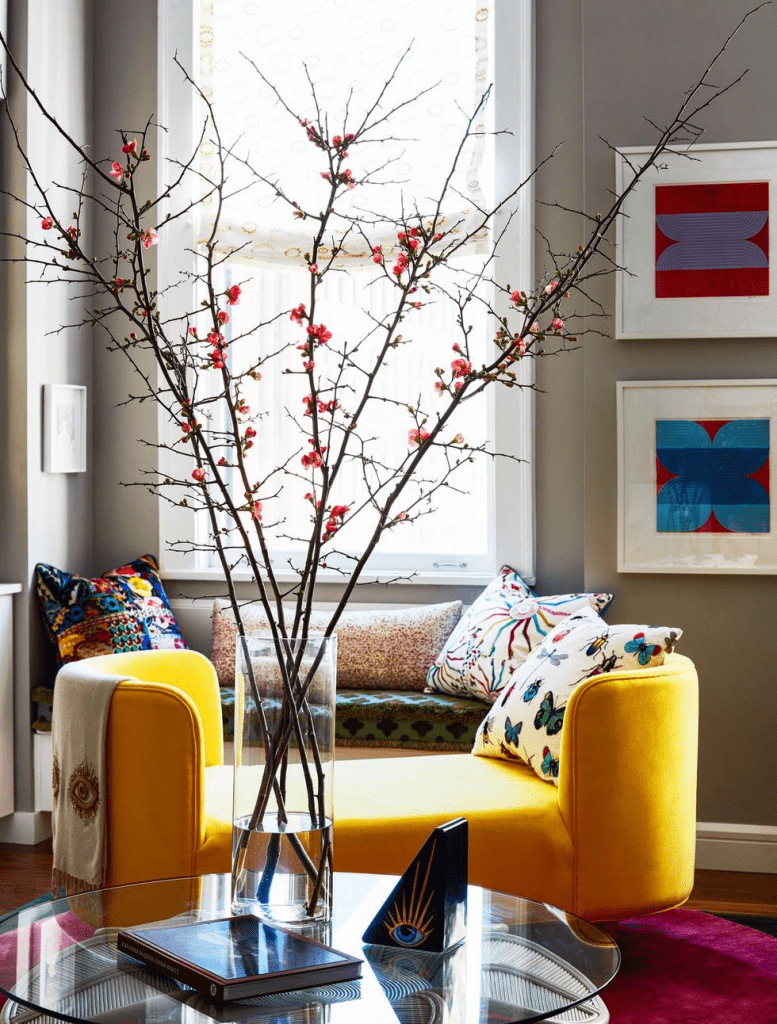
To prevent your living room from looking flat and uninspiring, introduce texture and patterns through various elements. Texture adds visual interest and tactile appeal to the space, making it feel more inviting and cozy.
Consider incorporating textured throw pillows, plush rugs, and curtains with interesting weaves or prints. Mix and match different fabrics, such as velvet, linen, or faux fur, to add depth and variety. Additionally, patterns can inject personality and liveliness into your living room.
Experiment with patterned wallpapers, bold area rugs, or accent pillows with intricate designs. Be mindful of balancing the patterns with solid colors to maintain a cohesive and visually pleasing look.
12. Introduce Natural Elements
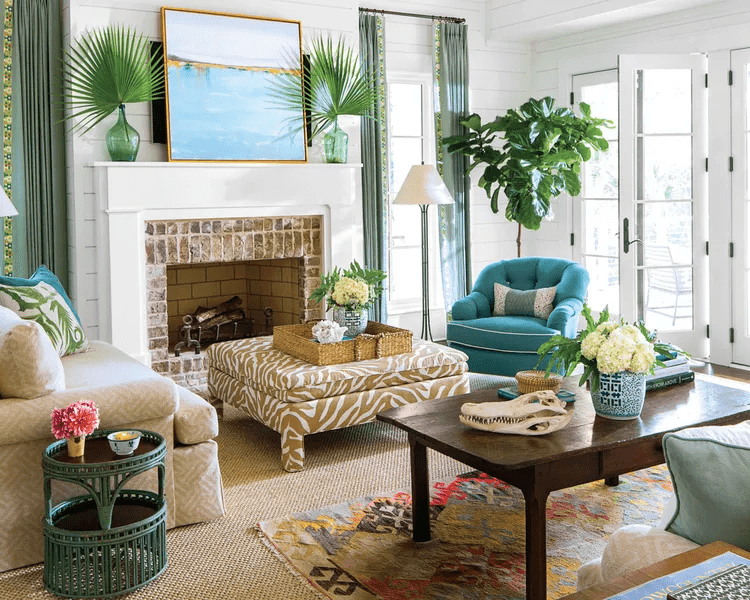
Bringing elements of nature into your living room can enhance its overall appeal and create a soothing environment. Incorporate houseplants to add a touch of greenery and freshen the air.
Choose plants that thrive indoors and are low-maintenance, such as succulents or peace lilies. Display fresh flowers in vases to add a pop of color and fragrance. In addition to plants, incorporate natural materials like wood, stone, or rattan.
This can be done through furniture pieces, such as a wooden coffee table or a stone accent wall, or through smaller decor items like woven baskets or natural fiber rugs. By embracing nature, you create a harmonious and calming atmosphere in your living room.
13. Personalize with Art and Accessories
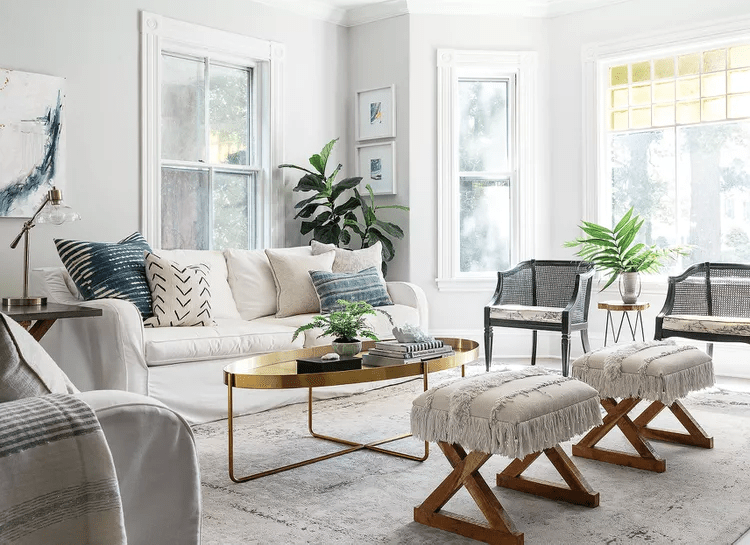
Make your living room feel like a true reflection of your personality by adorning the walls with art and displaying meaningful accessories. Artwork adds visual interest and acts as a conversation starter.
Choose pieces that resonate with you and complement the style of your living room. Consider a mix of paintings, photographs, or even sculptures. Gallery walls can be a great way to display a collection of smaller artworks. In addition to art, incorporate accessories that hold personal significance, such as family photographs, travel souvenirs, or heirlooms.
These items not only add character to your living room but also create a sense of warmth and nostalgia.
14. Define Zones within the Room

If your living room serves multiple purposes, consider defining separate zones to make the most of the space. This is particularly important in open-concept living areas or small apartments. Determine the different activities that will take place in the room, such as lounging, dining, or working, and create designated areas for each.
Use rugs and furniture placement to visually separate these zones. For example, position a sofa and a coffee table in one area for relaxation and conversation, and set up a dining table and chairs in another area for meals and gatherings.
If you have a small nook or corner, you can transform it into a cozy reading or workspace by adding a comfortable chair, a small desk, and proper lighting. By defining zones, you maximize the functionality of your living room and create distinct spaces for different activities.
15. Creating a Shopping List
To ensure a smooth and organized process as you decorate your living room, it’s helpful to create a shopping list of the items you need. This will help you stay focused and avoid impulse purchases, saving you time and money.
Remember to review your shopping list and prioritize items based on your budget and the most essential elements for your living room. Take measurements and gather inspiration to make informed decisions when shopping.
With a well-prepared shopping list, you’ll be equipped to find the right items and create the living room of your dreams.
Most Popular Post:
10 Surprising Benefits of Printable Wall Art
15 Must-Have Accessories For Styling A Coffee Table
How to Choose the Perfect Interior Color Scheme for Your Home
Expert Guide On How To Buy A Rug For Each Room
In conclusion, decorating a living room from start to finish can be an exciting and rewarding endeavor. By following the best tips and incorporating thoughtful design choices, you can transform your living room into a welcoming and stylish space that reflects your personal taste and meets your functional needs.
Throughout this article, we’ve explored a range of essential aspects to consider when decorating a living room. We started by emphasizing the importance of defining the function of your living room, whether it’s for entertainment, socializing, work, or showcasing art. Understanding the purpose of the space helps guide your design decisions and ensures that the final result aligns with your lifestyle.
We discussed the significance of measuring your living room accurately. Proper measurements enable you to select appropriately sized furniture, plan the layout effectively, and optimize the flow and movement within the room. By measuring doorways, windows, and architectural features, you can ensure that your chosen furniture and decor items can be easily transported into the room and seamlessly integrated into the design.
We highlighted the significance of starting with the sofa, as it sets the tone for the entire space. Choosing a sofa that fits the scale of your living room, aligns with your style preferences, and provides comfort is crucial. With the sofa as a foundation, you can then build the rest of your design, incorporating complementary furniture pieces, accent chairs, and coffee tables.
We also discussed the impact of adding an area rug to your living room. An area rug can enhance the visual appeal, define specific zones within the space, and add a cozy element. We emphasized the importance of selecting the right size, style, and placement for the rug to create a harmonious and inviting atmosphere.
To ensure a smooth and organized decorating process, we recommended creating a shopping list. This list should include essential items such as the sofa, coffee table, accent chairs, lighting fixtures, rugs, storage solutions, decorative accents, window treatments, and paint or wallpaper if needed. A well-prepared shopping list helps you stay focused and make informed decisions while avoiding unnecessary purchases.
In conclusion, decorating a living room from start to finish requires thoughtful planning, attention to detail, and a cohesive vision. By incorporating the best tips discussed in this article, such as defining the function of your living room, accurate measurements, starting with the sofa, adding an area rug, and creating a shopping list, you can achieve a beautifully designed living room that meets your style preferences and enhances your everyday living experience.
So, roll up your sleeves, gather your inspiration, and embark on this exciting journey of transforming your living room into a space that truly reflects your personality and brings joy to all who enter.
FAQs:
Q: What are the best tips to decorate a living room from start to finish?
A: The best tips to decorate a living room from start to finish include defining the function of your living room, measuring the space accurately, starting with the sofa, adding an area rug, and creating a shopping list. These tips ensure a well-planned and cohesive design process.
Q: How do I choose the right size sofa for my living room?
A: To choose the right size sofa, measure your living room and consider the available space. The sofa should fit comfortably without overwhelming the room or obstructing walkways. Additionally, consider the seating capacity you need and whether a traditional sofa or sectional would work best for your living room.
Q: What should I consider when selecting an area rug?
A: When selecting an area rug, consider the size, style, and placement. Measure the seating area and choose a rug that is large enough for the front legs of your furniture to sit on. Select a style that complements the overall design theme of your living room and ensure proper placement to anchor the furniture arrangement.
Q: How do I plan the layout of my living room?
A: To plan the layout of your living room, consider the flow and function of the space. Arrange furniture to create conversation areas and ensure easy movement. Take into account the focal point, such as a fireplace or TV, and position furniture accordingly. Experiment with different arrangements to find the most functional and visually pleasing layout.
Q: How can I make my living room feel more spacious?
A: To make your living room feel more spacious, choose furniture that is appropriately scaled for the room. Opt for lighter colors and avoid bulky or oversized pieces. Maximize natural light by using sheer curtains or blinds, and incorporate mirrors to create the illusion of space. Declutter regularly to maintain an open and airy feel.
Q: What are some budget-friendly decorating ideas for a living room?
A: Some budget-friendly decorating ideas for a living room include repurposing existing furniture with new upholstery or a fresh coat of paint, DIY projects such as creating artwork or decorative accents, shopping at thrift stores or online marketplaces for unique and affordable pieces, and utilizing accessories such as throw pillows, rugs, and curtains to refresh the space without breaking the bank.
GET CAUGHT UP ON ALL THE INSPIRING DECOR TIPS:
18 Fresh Decorating Ideas To Update Your Fireplace

How To Create An Art Gallery Wall

How To Decorate a Living Room With White Walls
CATCH THE LATEST IN HOME DECOR TRENDS:
Steal These 15 Expert-Approved Decorating Secrets

How To Accessories Your Living Room

Small Space? 10 Ways To Make A Room Appear Bigger

Make Your space Look Expensive
